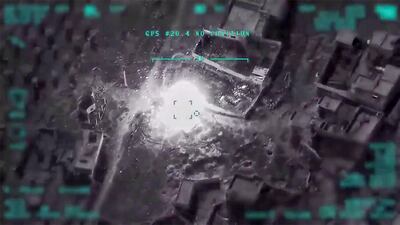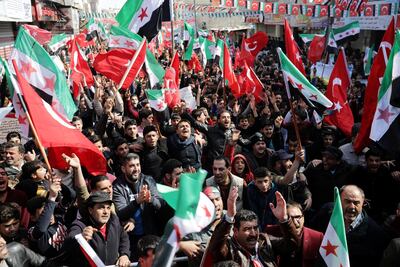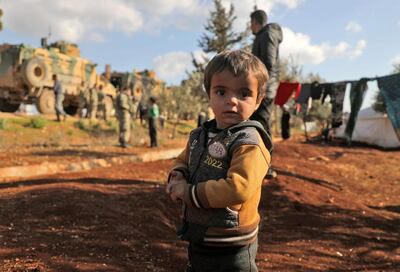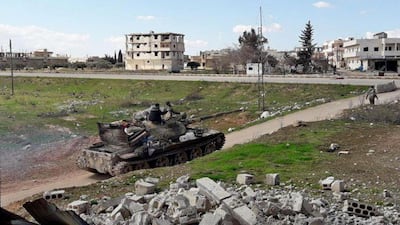The videos are surreal. Black and white drone footage showing columns of armoured vehicles, suddenly obliterated en masse. Smoke billows from a building in the distance. Men running away or rushing into buildings just before a missile races to the ground, leaving nothing but ash in its wake.
For the first time in the Syrian civil war, it is not Bashar Al Assad’s regime – or the Russian Air Force – that is dominating the skies and inflicting suffering on those below. Turkish drones are wreaking havoc on Syrian armour, and the mounting casualties, in men and arms, have underlined once again the precarious state of Mr Al Assad’s Syria.
And for many Syrians forced into exile by nearly a decade of war, it has raised the question of why exactly it took nine years for anyone in the international community to act to prevent the advances of the Syrian army, and the killing and displacement of so many civilians.
Ankara's wide-ranging offensive over the past few days in north-western Syria came after air strikes that killed 32 Turkish soldiers stationed in the province of Idlib, sent there to reinforce observation points that were supposed to ensure against fighting between rebels and the regime. Instead, Mr Al Assad launched a brutal assault on Idlib that displaced a million people between December and late February. Children froze to death as they sought shelter near the closed Turkish border in flimsy tents, and hospitals and schools were bombed.

Turkey’s campaign, dubbed Operation Spring Shield, has halted and even reversed the regime offensive in some parts of Idlib. Ankara destroyed two Syrian fighter jets, eight helicopters, 135 tanks and five air defence systems, by its defence minister’s count. Mr Al Assad’s military losses are some of the worst since the start of the conflict.
It is impossible to determine the number of Syrian soldiers killed in the fighting. The government is unlikely to admit to such losses. Open source researchers such as Gregory Waters have identified dozens of death notices on social media, including fighters from Hezbollah as well as the Fatemiyoun and Zaynabiyoun brigades – Pakistani and Afghan fighters drafted by Iran’s Islamic Revolutionary Guard Corps to fight in Syria. In one video by a Hezbollah fighter on social media, he complained that Turkish drones had “harvested” pro-regime fighters, indicating large-scale deaths in combat. Ankara’s figure of more than 2,500 dead is likely to be an exaggeration, but hundreds of Mr Al Assad’s loyalists appear to have perished in the campaign.
It is unlikely that Mr Al Assad’s forces can sustain these losses for much longer, exhausted and depleted as they are by years of fighting and being forced to wage battle for the first time in the war without air superiority, which they used to massacre and carry out atrocities in order to terrify rebellious communities into submission.

The losses pierce the pervasive image that Mr Al Assad’s forces have unchallenged momentum, and that reclaiming the rest of the country was only a matter of time. In fact, the reversal of fortunes on the battlefield could not come at a worse time internally for the regime.
Ordinary Syrians are suffering from profound deprivation. A collapsing currency, harsh winter, rampant poverty and unemployment have combined to leave many unable to afford basic staples or even fuel to power heaters or generators. Families in regime-held areas are going hungry, and with relief in the form of lifted sanctions or reconstruction aid or an economic revival unlikely in the short term, ordinary civilians are headed towards more destitution.
And the regime’s brutality in victory, with no prospect of real reform, means that long-term peace cannot be a reality. Mr Al Assad’s totalitarian security apparatus is still dominant, thousands of detainees remain disappeared, likely to have been tortured or killed. Already, low-level insurgencies are brewing in communities that have supposedly been reconciled with the regime, such as in Daraa, where the revolution began.

However, Mr Al Assad’s losses over the past few days – and the grounding of his air force – bought a little respite for the three million civilians of Idlib, most of whom are women and children, who were just last week fleeing for their lives.
Russia stood aside as Turkey pummeled Mr Al Assad’s loyalists and grounded his planes. In a few hours, with minimal losses, Ankara inflicted enormous losses and halted the regime’s ground and air campaigns – and their attendant atrocities. For a brief moment, regardless of Turkey’s geopolitical aspirations, ordinary civilians were spared the slaughter.
It makes you wonder. Years ago, Barack Obama’s administration refused to act in Syria despite spiralling atrocities and the use of chemical weapons. A no-fly zone to protect civilians from marauding Syrian fighter jets was derided as impractical, dangerous, too complicated, likely to lead to western casualties. Three days of the Turkish campaign have exposed the rot at the core of the Syrian regime’s supposed military prowess – it is only capable of defeating defenceless children.
It also exposed the rotten calculus of the international community, which stood aside and enabled the slaughter. Why was nothing done before, when it would have cost so little? Some half a million lives later, we know the answer. It was not because the international community did not have the means to do it. It is because Syrian lives meant nothing to them.
Kareem Shaheen is a former Middle East correspondent based in Canada


